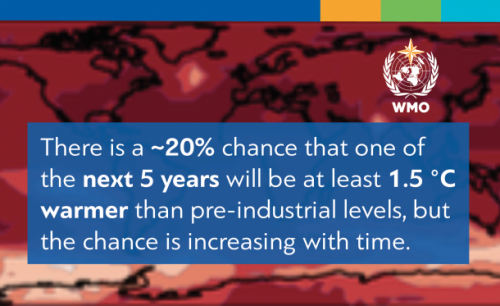
https://public.wmo.int/en/media/press-release/new-climate-predictions-as...
The Global Annual to Decadal Climate Update, led by the United Kingdom’s Met Office, provides a climate outlook for the next five years, updated annually. It harnesses the expertise of internationally acclaimed climate scientists and the best computer models from leading climate centres around the world to produce actionable information for decision-makers.
The earth’s average temperature is already over 1.0 C above the pre-industrial period. The last five-year period has been the warmest five years on record.
“This study shows – with a high level of scientific skill – the enormous challenge ahead in meeting the Paris Agreement on Climate Change target of keeping a global temperature rise this century well below 2 degrees Celsius above pre-industrial levels and to pursue efforts to limit the temperature increase even further to 1.5 degrees Celsius,” said WMO Secretary-General Petteri Taalas.
The predictions take into account natural variations as well as human influences on climate to provide the best possible forecasts of temperature, rainfall, wind patterns and other variables for the coming five years. The forecast models do not take into consideration changes in emissions of greenhouse gases and aerosols as a result of the coronavirus lockdown.
“WMO has repeatedly stressed that the industrial and economic slowdown from COVID-19 is not a substitute for sustained and coordinated climate action. Due to the very long lifetime of CO2 in the atmosphere, the impact of the drop in emissions this year is not expected to lead to a reduction of CO2 atmospheric concentrations which are driving global temperature increases,” said Professor Taalas.
“Whilst COVID-19 has caused a severe international health and economic crisis, failure to tackle climate change may threaten human well-being, ecosystems and economies for centuries, Governments should use the opportunity to embrace climate action as part of recovery programmes and ensure that we grow back better,” he said.
Professor Adam Scaife is the head of long-range prediction at the Met Office Hadley Centre. He said: “This is an exciting new scientific capability. As human-induced climate change grows, it is becoming even more important for governments and decision makers to understand the current climate risks on an annually-updated basis.”
Highlights
- Annual global temperature is likely to be at least 1°C warmer than preindustrial levels (defined as the 1850-1900 average) in each of the coming 5 years and is very likely to be within the range 0.91 – 1.59°C
- There is a ~70% chance that one or more months during the next 5 years will be at least 1.5°C warmer than preindustrial levels
- There is a ~20% chance that one of the next 5 years will be at least 1.5°C warmer than preindustrial levels, but the chance is increasing with time
- It is extremely unlikely (~3%) that the 5 year mean temperature for 2020-2024 will be 1.5°C warmer than preindustrial levels
- Over 2020-2024, almost all regions, except parts of the southern oceans, are likely to be warmer than the recent past
- Over 2020-2024, high latitude regions and the Sahel are likely to be wetter than the recent past whereas northern and eastern parts of South America are likely to be dryer
- Over 2020-2024, sea-level pressure anomalies suggest that the northern North Atlantic region could have stronger westerly winds leading to more storms in western Europe
- In 2020, large land areas in the Northern Hemisphere are likely to be over 0.8°C warmer than the recent past (defined as the 1981-2010 average)
- In 2020, the Arctic is likely to have warmed by more than twice as much as the global mean
- The smallest temperature change is expected in the tropics and in the mid-latitudes of the Southern Hemisphere
- In 2020, many parts of South America, southern Africa and Australia are likely to be dryer than the recent past
The development of near-term prediction capability was driven by the WMO co-sponsored World Climate Research Programme, which declared it as one of its overarching Grand Challenges.
With the UK’s Met Office acting as lead centre, climate prediction groups from Spain, Germany, Canada, China, USA, Japan, Australia, Sweden, Norway and Denmark contributed new predictions this year. Combining forecasts from climate prediction centres worldwide enables a higher quality product than what can be obtained from any single source.










Add new comment